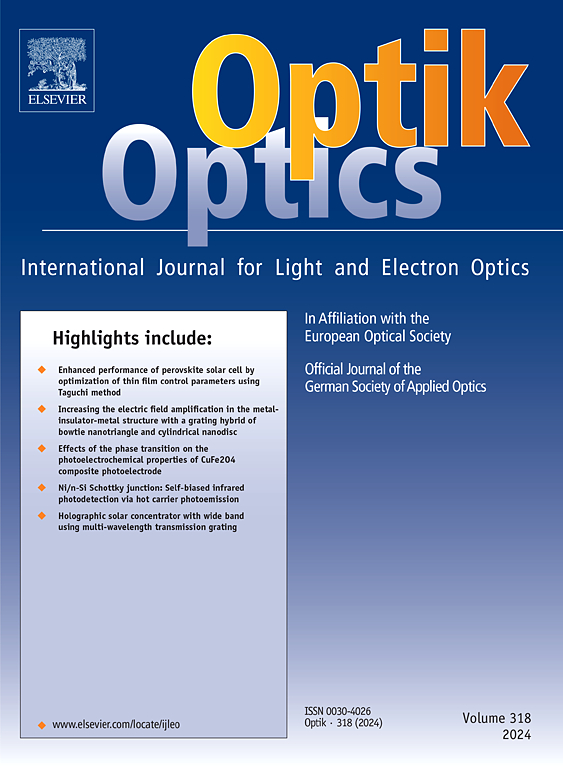Increasing the electric field amplification in the metal-insulator-metal structure with a grating hybrid of bowtie nanotriangle and cylindrical nanodisc
IF 3.1
3区 物理与天体物理
Q2 Engineering
引用次数: 0
Abstract
In this paper, the strong electromagnetic coupling between an integrated grating of an array of periodic gold nanodiscs and an array of bowtie nanotriangles placed on layers of a dielectric and a metal has been investigated. The upper layer is periodically created by removing each nanodisk in the array of nanodisks and replacing it with bowtie nanotriangles. The structure for near field radiation with linear polarization at 800 nm wavelength is optimized so that it has the highest amount of amplification in the gap space between the tips of the nanotriangle with a minimum value of 188 times and a maximum of 320 times. The simulation results confirm that the huge field enhancement obtained is due to the strong coupling between the LSPR formed in the grating of bowties nano triangle and nanodiscs and the SPPs formed in the metal film. The amount of amplification compared to the array of only nanodiscs (about 32 times) or only bowtie nano triangles (about 120 times) is not only higher, but also the anti-crossing behavior is observed. The high amplification obtained at the mentioned wavelength can be used for laser oscillators with a central wavelength of 800 nm, such as titanium sapphire, etc., which has many applications in near-field physics, SERS, and ultrafast lasers.
利用弓形纳米三角和圆柱形纳米圆盘混合光栅提高金属-绝缘体-金属结构中的电场放大率
本文研究了周期性金纳米盘阵列集成光栅与置于电介质和金属层上的弓形纳米三角形阵列之间的强电磁耦合。上层是通过移除纳米盘阵列中的每个纳米盘并用弓形纳米三角形取而代之而周期性形成的。对波长为 800 nm 的线性偏振近场辐射结构进行了优化,使其在纳米三角形尖端之间的间隙空间中具有最大的放大量,最小值为 188 倍,最大值为 320 倍。模拟结果证实,获得的巨大场增强是由于弓形纳米三角形和纳米圆盘光栅中形成的 LSPR 与金属膜中形成的 SPP 之间的强耦合。与只有纳米圆盘的阵列(约 32 倍)或只有弓形纳米三角形的阵列(约 120 倍)相比,放大量不仅更高,而且还观察到了反交叉行为。在上述波长下获得的高放大率可用于中心波长为 800 nm 的激光振荡器,如钛蓝宝石等,这在近场物理、SERS 和超快激光等领域有很多应用。
本文章由计算机程序翻译,如有差异,请以英文原文为准。
求助全文
约1分钟内获得全文
求助全文
来源期刊

Optik
物理-光学
CiteScore
6.90
自引率
12.90%
发文量
1471
审稿时长
46 days
期刊介绍:
Optik publishes articles on all subjects related to light and electron optics and offers a survey on the state of research and technical development within the following fields:
Optics:
-Optics design, geometrical and beam optics, wave optics-
Optical and micro-optical components, diffractive optics, devices and systems-
Photoelectric and optoelectronic devices-
Optical properties of materials, nonlinear optics, wave propagation and transmission in homogeneous and inhomogeneous materials-
Information optics, image formation and processing, holographic techniques, microscopes and spectrometer techniques, and image analysis-
Optical testing and measuring techniques-
Optical communication and computing-
Physiological optics-
As well as other related topics.
 求助内容:
求助内容: 应助结果提醒方式:
应助结果提醒方式:


